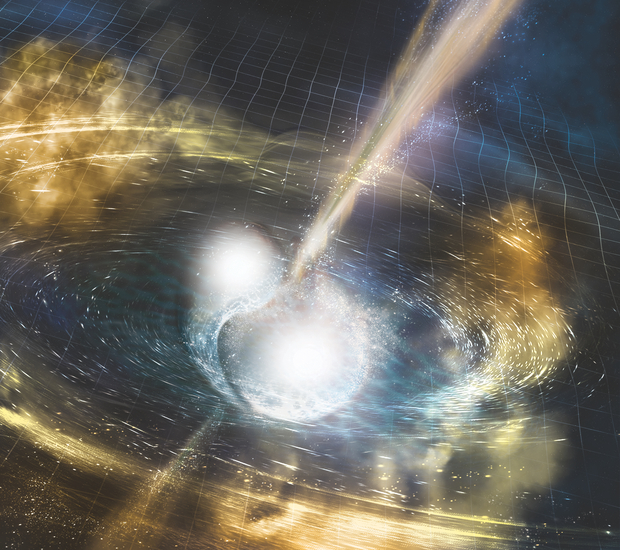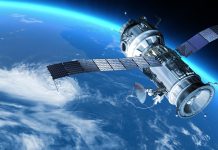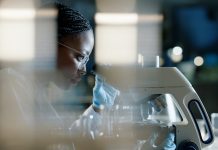Richard F. Green, Director, Division of Astronomical Sciences, U.S. National Science Foundation (NSF) explores the wonders of astronomy and the universe of discovery
In October 2017, telescopes across the globe observed a kilonova radiating from a galaxy 130-million- light-years from Earth. Thousands of scientists saw the event unfold, the explosive aftermath of paired neutron stars colliding. Selected by Science Magazine as its Breakthrough of the Year, it was the first time in history that the world’s telescopes were guided to a new discovery by gravitational wave detectors and it ushered in a new era for astronomy.
The merger’s initial detection by NSF’s Laser Interferometer Gravitational-Wave Observatory (LIGO) and Europe’s Virgo facility was exciting, but the historic breakthrough was the rapid deployment of other observatories to identify and then image, the radiating emissions. Six research teams independently made the initial optical identification; four were based in the United States and NSF Astronomy supported all four. NSF continues to highlight this multi-messenger revolution as one of its major cross-cutting themes: Windows on the Universe.
The NSF Division of Astronomical Sciences has a mission to promote such excellence in U.S. ground-based astronomy. Toward that goal, the Division invests in three approaches: support the programmes of individual investigators, provide access to world-class research facilities and datasets; and enable the development of new instrumentation and next-generation facilities – all through competitive merit review.
The result? Breakthrough science
For example, on December 6th, 2017, Nature published online the discovery of the most distant quasar yet detected, a massive radiator of energy powered by an 800-million-solar-mass black hole. The research team, supported by our division, selected quasar candidates with distinct colour patterns using data from the NSF-supported Dark Energy Camera Legacy Survey on the NSF Blanco 4-metre telescope. The discovery was important not only for what it revealed but also for the questions it raises. The black hole is from a time when the universe was only 5% of its current age – much less time than current models predict for a small black hole to grow to that size by accreting that much mass.
Also last year, the Atacama Large Millimeter Array (ALMA) captured the telltale signature of the cold gas and dust energised by newly formed stars. While such a signature is not uncommon, this discovery also raised interesting questions: the newly formed stars are in the immediate vicinity of the four-million-solar-mass black hole in the centre of our Milky Way Galaxy. Conventional wisdom suggests the powerful radiation and particle jets from that black hole disrupt the cold condensation of gas that leads to new stars, so the discovery is a surprise and a puzzle.
And perhaps most widely reported and tied to the nation’s most popular astronomical event in some time, NSF’s National Solar Observatory (NSO) recruited citizen scientists to track the U.S. solar eclipse in August 2017 for the entire duration of its transit. The resulting video captured the public’s imagination and raised NSO’s profile and provides the longest data set of its kind.
This year, NSO also drew attention for its recent development of state-of-the-art techniques for sharpening real-time images of the sun to correct for the blur of the Earth’s turbulent atmosphere. The resulting images reach a resolution of 40 km over an extent of 25,000 km on the sun’s surface. This same technology applied at the nearly completed Daniel K. Inouye Solar Telescope (DKIST) will achieve 2.5 times sharper imaging, enabling scientists to understand in detail the bubbling of gas that transports heat to the sun’s surface along with the magnetic fields that create space weather.
The current flagship facilities in ground-based astronomy are truly multi-national in nature. For example, the three executives of ALMA are NSF, the European Southern Observatory and the National Astronomical Observatory of Japan, with Chile, Canada and Taiwan as collaborators. ALMA consists of 66 radio dishes located at an elevation of 5 km above sea level in the Atacama Desert of northern Chile.
The Gemini twin, 8-metre, optical-infrared telescopes are a fusion of national and international efforts. One of the telescopes is located on Cerro Pachón in northern Chile, while its twin is located on Mauna Kea in Hawai’i. The Gemini Observatory is operated as a partnership among the U.S. (represented by NSF), Canada, Chile, Brazil and Argentina, with South Korea as a limited-term collaborator.
Hawai’i is also the site of NSF’s DKIST on the island of Maui, which is generating considerable excitement as it will be the world’s largest solar telescope when completed in 2020. It will revolutionise our understanding of the sun’s magnetic energy and its impact on space weather and the Earth. The UK and Germany are contributing to the first-light instrument complement.
Similar excitement is building for the Large Synoptic Survey Telescope (LSST), which will be a neighbour of Gemini South on Cerro Pachón in Chile. Its 8-metre primary mirror will focus on a 3-billion-pixel CCD camera, taking exposures every 20 seconds to produce a movie of the sky in multiple colours. It will ultimately measure the detailed properties of dark matter and dark energy while opening up the uncharted discovery space of the faint transient universe – the explosions and pulsations of distant stars and black holes and the motions of the myriad bodies in the inner and outer solar system.
LSST is supported by NSF, the Department of Energy and an international partnership including 23 countries through the LSST Corporation. Dealing with the flood of data from DKIST and LSST will require a new generation of techniques and data-handling interfaces, another major NSF initiative we call Harnessing the Data Revolution.
Recent advances in astronomy have been heavily driven by discovery from new data, new facilities and state-of-the-art instrumentation. The NSF Division of Astronomical Sciences supports the discoverers and their tools to drive those advances.
“The views expressed in this article do not necessarily represent the views of the National Science Foundation or the United States.”
Richard F. Green
Director
Division of Astronomical Sciences, U.S. National Science Foundation (NSF)
Tel: +1 (703) 292 8820











